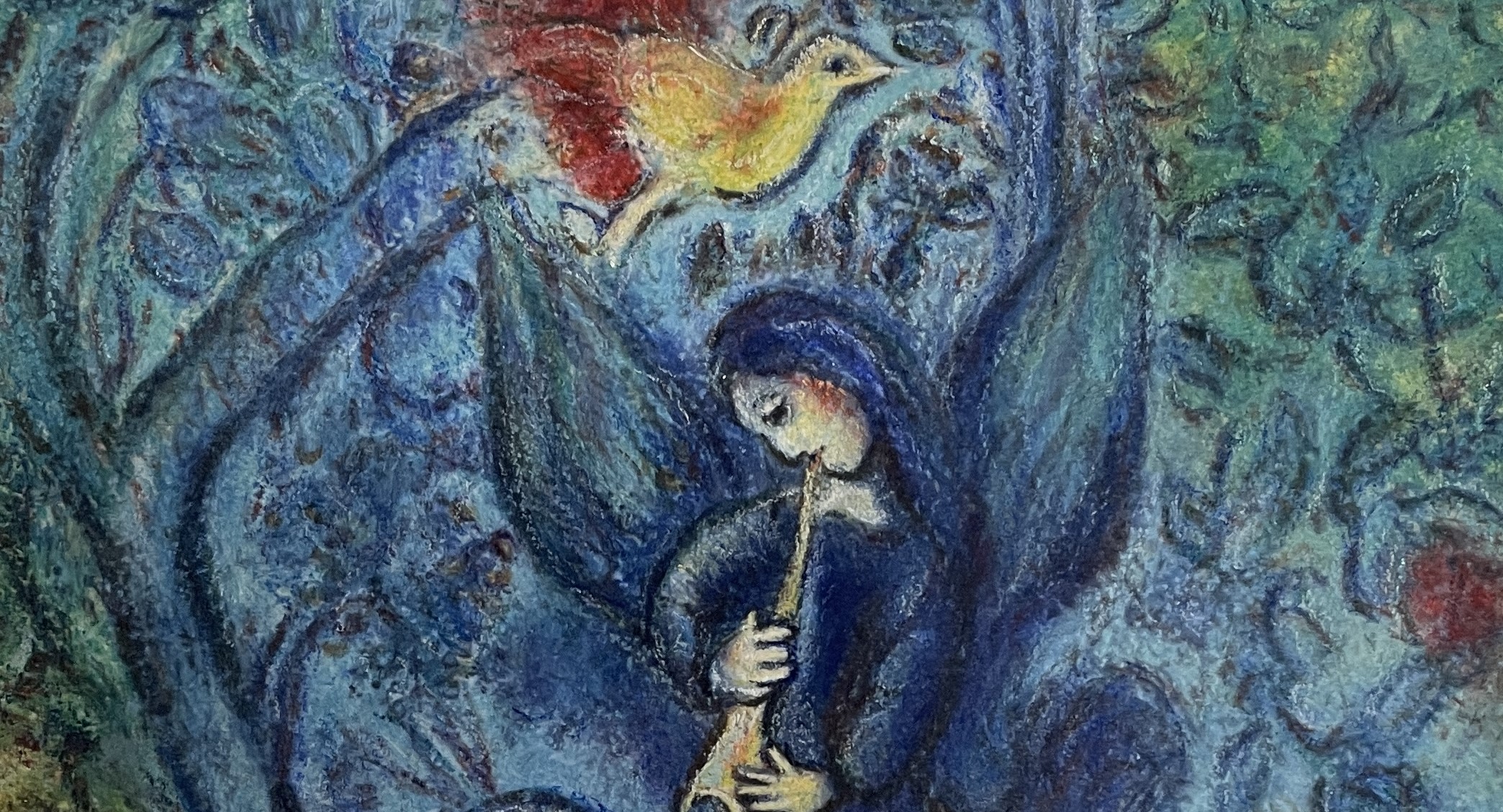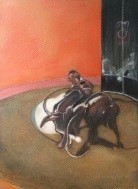日本語-Englishー台灣華語
フランシス・ベーコン「闘牛のための習作No.1」
フランシス・ベーコンの絵をはじめて観たのはもう30年以上も前のことだ。フランシス・ベーコンの哲学は大学生の時にかじり知ってはいたが、絵画を描いているとは知らなかった。はじめて観るベーコンの絵は、激しくデフォルメされ、歪められ、私は大きなショックを受けた。不安を煽る画面だが、そこには激しいエネルギーと生への執着が満ち溢れており、忘れられない印象を残した。後に画家のベーコンは哲学者ベーコンとは別人であることを知るのだが、その時は哲学的に考えてばかりいると、暴力的に憂さを晴らさないとバランスがとれないのだろうと、妙に納得したのを覚えている。私はこうして画家ベーコンに出会った。
画家フランシス・ベーコンが私にとって特別なのは、この画家が正規の学校教育を受けず、ましてや美術の専門教育も受けずに画家になったからだ。ベーコンは若い頃ロンドンで家具のデザイナーとして身をたてていたが、ある時ピカソの絵画を観て「これなら自分でも出来る」と突然画家になることを決意する。今となっては絵画取引価格もピカソ並みになっている。 私はベーコンの決意にあやかって、ピカソがこよなく愛した闘牛をテーマとした絵を描くことにする。私はスペイン投資の仕事をしていた関係で何度もスペインで本場の闘牛を見物したことがある。闘牛はただの牛と人間の殺し合いではない。実際に観ると死を様式にまで高めた美意識を感じることができる。ベーコンにとっては相応しい画題である。
ベーコンの絵画は、同じ歪められた画面であっても、ピカソとは異なり、流動的な動きがあり感情的である。ピカソは画風・描写方法とも時代によって大きく変化するが、ベーコンの絵画は複雑なように見えて概ね定型化された要素で構成されている。ベーコンの絵は、絵の具が生乾きの状態で引きずりながら、歪むように描いた人物が中心にある。リヒターの抽象画のような描き方であるが、人物は乱雑なようでいて実に丁寧に描かれている。中心テーマである人物とは対照的に背景は単色で平塗されている。時にアクションペインティングのように乱雑に不定形なものが描き加えられる。闘牛のための習作No.1においても、闘牛士と牛の格闘に力が注がれている。闘牛士は典型的なベーコンの人物画のように引きずるように表情が描かれ、牛の躍動する動きが牛の生来の斑模様と相まって溶け合っている。右上の観客席は枢機卿の肖像画のように全体が縦に引きずるように描かれている。背景はオレンジ一色に塗り込められている。対照的に闘牛場の土が意外に複雑な色彩で構成され、闘牛士と牛の格闘が一筋縄ではないことを伝えている。闘牛士と牛が最も間近にせめぎ合う闘牛場の壁はピンクに塗られ、死と隣り合わせのエロティックな行為を暗示している。
画家になった経緯がそう思わせるのか、ベーコンは破綻型の人物を演じながら、なかなかの商売人である。ベーコンの絵画は三幅対(トリプティック)になっている作品が多い。三幅対には頭部だけをクローズアップした作品と、人体が全身で描かれた作品の二種類がある。いずれの作品もほぼ同じ規格サイズである。大きなサイズはベーコンのアトリエが極端に狭かったために搬出できるように三幅対にしたとも言われているが、描く立場からすれば、画面を分割することで気分がその都度切り替わり、仕上げ易くなったのだと思う。三幅対と融合させたベーコン絵画は、伝統的キリスト教絵画、とりわけ祭壇画で多用されてきた三幅対にすることで宗教的ニュアンスも醸し出している。その絵画は画家自らが指定した規格化された黄金の額縁に、供物のごとく封じこめられている。
ベーコンの絵には肉体と死のエロスが満ちている。ベーコンはエロティックな欲望を満たすには、清潔で無機的な空間で、暴力的に溶解することが必要であると頑なに考えていた。ベーコンが多用する「肉」のモチーフには長い歴史がある。「肉欲」という言葉が示すように、欲望と快楽といった性的な意味合いに加え、堕落と結びついた否定的なモチーフである。聖書にある肉欲の否定を源流とするもので「罪」を象徴している。ベーコンの作品は罪の画題をあえて聖性へと昇華させている。暴力的に歪んだ肉体は聖なるものとして磔刑図のように描かれている。有名な「叫ぶ教皇」も単なるベラスケスへのオマージュという以上に、あえて聖性を破壊している。ベーコンの絵は、自らの嗜好に忠実であることが、真の画家になるには必要であることを教えてくれる。同時にただ描くのではなく、高次元に画題を解釈しなおすことで、絵画の価値が高まりことを暗示している。
Study for a Bullfight No.1
I first saw a painting by Francis Bacon more than 30 years ago. Although I had dabbled in Francis Bacon’s philosophy during my university years, I was unaware that he painted. The first Bacon painting I saw was intensely deformed and distorted, which shocked me greatly. Although the painting stirred unease, it overflowed with fierce energy and a clinging to life, leaving an unforgettable impression. I later learned that the painter Bacon was a different person from the philosopher Bacon, but at the time, I oddly convinced myself that perhaps being philosophical all the time required a violent outlet to maintain balance. This is how I encountered the painter Bacon.
What makes Francis Bacon special to me is that he became a painter without any formal school education, let alone specialized art training. Bacon had established himself as a furniture designer in London when, upon seeing a painting by Picasso, he suddenly decided that he could be a painter too. Now, his paintings fetch prices comparable to Picasso’s.
Inspired by Bacon’s resolve, I decided to paint themes of bullfighting, which Picasso dearly loved. Having worked in Spanish investments, I had seen bullfights in Spain several times. Bullfighting is not merely a fight to the death between a bull and a human. Watching it in person, one can appreciate an aesthetic that elevates death to a form of art. It was a fitting subject for Bacon.
Bacon’s paintings, though also distorted, differ from Picasso’s in that they possess fluid movement and emotion. While Picasso’s style and method of depiction changed significantly over time, Bacon’s paintings seem complex but are generally composed of standardized elements. His works center on figures drawn as if being dragged through semi-dry paint, distorted. This method is similar to Richter’s abstract painting, but the figures, though appearing haphazard, are actually drawn with great care. In contrast to the central figures, the background is uniformly painted in a single color. At times, action painting-like, formless additions are made. In “Study for a Bullfight No.1,” focus is given to the struggle between the matador and the bull, with the matador’s expression dragged out in typical Bacon style, and the bull’s dynamic movement blending with its natural patterning. The spectators in the upper right are drawn as if dragged vertically, reminiscent of a cardinal’s portrait. The background is painted entirely in orange. Contrarily, the bullfighting arena’s soil is unexpectedly complex in color, indicating that the conflict between the matador and the bull is not straightforward. The wall of the bullfighting arena, where the matador and bull clash closely, is painted pink, hinting at an erotic act juxtaposed with death.
Perhaps due to the circumstances of becoming a painter, Bacon was quite the businessman while portraying disrupted figures. Many of Bacon’s paintings are triptychs, featuring either close-ups of heads or full-body depictions of human figures. These works are almost always of a standard size. It is said that the large size was due to the extreme narrowness of Bacon’s studio, allowing for transport in triptych form, but from the artist’s perspective, dividing the canvas likely made it easier to switch moods and finish the work. Bacon’s fusion with the triptych format also imbues a religious nuance, reminiscent of traditional Christian art, especially altarpieces. These paintings are encased in standardized golden frames specified by the artist himself, as if sealed as offerings.
Bacon’s paintings are filled with the eros of flesh and death. He stubbornly believed that to satisfy erotic desires, one must dissolve violently in a clean, inorganic space. The motif of “flesh” that Bacon frequently used has a long history. As the word “carnal desires” suggests, it not only implies sexual connotations of desire and pleasure but also carries a negative motif associated with decay, originating from the biblical denial of carnal desires and symbolizing “sin.” Bacon’s works daringly sublimate the theme of sin into sanctity. The violently distorted bodies are depicted as sacred, akin to crucifixion scenes. The famous “Screaming Pope” is more than just an homage to Velázquez; it deliberately destroys sanctity. Bacon’s paintings teach us that being true to one’s tastes is necessary to become a true artist, while also hinting that reinterpreting themes at a higher level enhances the value of the artwork.
弗蘭西斯·培根「鬥牛為題的習作No.1」
我第一次看到弗蘭西斯·培根的畫作是在三十多年前了。大學時代我曾略知一二弗蘭西斯·培根的哲學,但並不知道他也畫畫。第一次看到培根的畫,那激烈的變形和扭曲給我帶來了巨大的震撼。畫面雖然令人不安,但充滿了強烈的能量和對生命的執著,留給我難以忘懷的印象。後來才知道,畫家培根和哲學家培根是兩個不同的人,當時我不禁認為,或許只有在哲學思考中尋求暴力的解脫,才能達到某種平衡,這種想法讓我感到有些奇怪的認同。就這樣,我遇到了畫家培根。
對我來說,弗蘭西斯·培根特別的地方在於,他沒有接受正規的學校教育,更不用說專業的藝術教育,卻成為了一名畫家。培根年輕時在倫敦做家具設計師,直到有一天看到畢卡索的畫作,他突然決定自己也能成為畫家。如今,他的畫作交易價格也與畢卡索不相上下。受培根決心的啟發,我決定畫畢卡索深愛的鬥牛主題。因為我從事西班牙投資工作,多次在西班牙親眼觀賞過真正的鬥牛。鬥牛不僅是人與牛的鬥爭,親眼目睹後,你會感受到將死亡提升為一種美學的感覺。這對培根來說是一個合適的題材。
培根的畫作,即使是同樣扭曲的畫面,也與畢卡索不同,有流動的動感和情感表達。畢卡索的畫風和描繪方式隨著時代大幅變化,而培根的畫作看似複雜,卻大致由定型的元素構成。培根的畫中,畫面中心的人物似乎在濕漉漉的顏料中被拖拽般扭曲。這種畫法類似於里希特的抽象畫,但人物雖然看似混亂,實則非常細膩地描繪。與人物形成對比的背景,通常是單色平塗。有時背景會隨意加入不定形的亂塗,類似於動作繪畫。在「鬥牛為題的習作No.1」中,鬥牛士與牛的搏鬥被賦予了力量。鬥牛士的表情如同培根典型的人物畫一樣被拖拽般描繪,而牛的活躍動作與其天然的斑紋融合在一起。右上角的觀眾席如同樞機主教的肖像畫一般,整體被縱向拖拽地描繪。背景被塗成了橙色。相對地,鬥牛場的土地色彩意外地複雜,傳達出鬥牛士與牛的格鬥不是那麼簡單。鬥牛場最近鬥牛士與牛相鬥的牆壁被塗成粉紅色,暗示著死亡與性的侵犯行為。
也許是成為畫家的經歷使然,培根在扮演破產人物的同時,也是一位相當不錯的商人。培根的畫作中有許多是三幅一組的作品,這些作品要么是頭部特寫,要么是全身描繪。這些作品幾乎都是相同的標準尺寸。據說大尺寸是因為培根的工作室極其狹窄,為了能夠搬運而設計成三幅一組,但從畫家的角度來看,分割畫面使得每次心情都能切換,更易於完成作品。將畫作與三幅一組融合,也賦予了培根的畫作傳統基督教繪畫,特別是祭壇畫中常用的三幅一組形式,從而散發出宗教的韻味。這些畫作被畫家自己指定的標準化的金色畫框封存,如同供品一般。
培根的畫充滿了肉體與死亡的色情。培根堅持認為,滿足色慾需要在乾淨無機的空間中暴力溶解。培根多用的「肉」主題有著悠久的歷史。「肉慾」一詞不僅涵蓋了性慾和快感的意義,還與墮落有關,是一種負面的象徵。源自聖經中對肉慾的否定,象徵「罪惡」。培根的作品敢於將罪惡的主題昇華為聖潔,暴力扭曲的肉體被描繪成聖物,如同受難圖。著名的「尖叫的教皇」不僅僅是對貝拉斯克斯的致敬,更是故意破壞聖潔。培根的畫告訴我們,對自己偏好的忠誠是成為真正畫家的必要條件,同時不僅僅是畫畫,而是通過重新解釋畫題在更高維度上提升畫作的價值。


